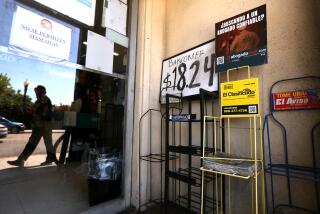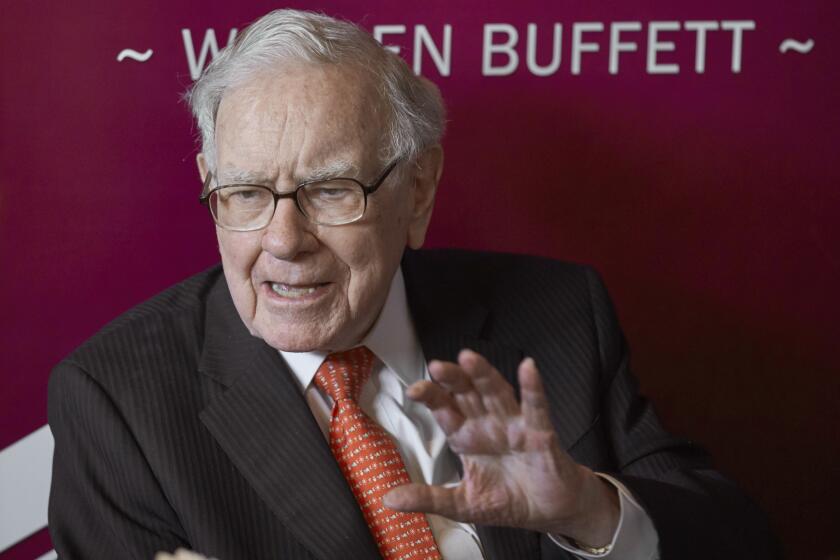Sunset magazine, a California icon, struggles amid declining ad sales and management missteps

- Share via
For 120 years, Sunset magazine has been synonymous with California living.
Created by Southern Pacific Railroad to promote westward travel, Sunset has long been a tastemaker for the masses, popularizing backyard barbecues, hot tubs, midcentury architecture, weekend getaways, California wines and food culture, including a boom in avocados. The pioneering publication survived the 1906 San Francisco earthquake, the Great Depression and ownership changes.
But there are dark clouds on Sunset’s horizon.
More than a dozen current and former employees and contributors interviewed by The Times describe an organization in disarray. Five top editors, including the editor in chief, have quit in recent weeks. Some freelance writers haven’t been paid for months. Sunset’s holiday issue, which typically lands in mailboxes in late November, has been delayed until nearly Christmas, in part because of a lack of advertising.
In September, Sunset’s staff was abruptly moved from its upscale waterfront offices to a WeWork communal workspace several blocks away in downtown Oakland. Without a test kitchen to fine-tune recipes or prepare dishes for photo shoots, editors schlepped food and supplies to a basement kitchen in Mountain View, which they shared with food truck vendors. Feral cats congregated near the door.
As staffers were settling into the WeWork space, the parking manager from the previous offices showed up unannounced, demanding that Sunset pay its past-due parking fees.
Problems have mounted since the magazine was sold a year ago to Regent, a small Beverly Hills private equity firm, for about $12 million (including liabilities) — a sliver of its value three decades ago.
Regent founder Michael A. Reinstein, in an interview, acknowledged a rocky transition from the previous owner, Time Inc. Editors left voluntarily, he said, because they decided they weren’t a good fit with the new cost-conscious approach. He added that he also wanted his own team, and had hired a new editor in chief from New York.
“This was a complete reboot,” said Reinstein, who specializes in buying distressed assets. “We’ve taken a start-up mentality.”
Reinstein said Sunset was not experiencing a cash crunch. He said his firm was simply working through a backlog of bills, and that he was invested in the magazine’s future.
“I view Sunset as my life’s work; making it live another 120 years is core to me,” he said. “I treasure this brand.”
Sunset’s struggles are emblematic of the challenges facing print media. Publications are suffering from a defection of advertisers to the internet. Magazines have been particularly hard hit; publisher Condé Nast last week announced it was ending the print edition of Glamour. Hearst is no longer printing Seventeen. Some billionaires have come to the rescue. This week, the philanthropic firm led by Laurene Powell Jobs, widow of the Apple Inc. co-founder, acquired the publisher of Pop-Up magazine and the California Sunday magazine. But such instances are rare.
“What makes this so sad is that it’s Sunset,” said Matt Villano, a travel writer and contributor since 2003. “This is a magazine that has existed almost as long as California.”
Sunset’s growth parallels that of California in the 20th century.
The magazine was born to coax travelers aboard Southern Pacific’s Sunset Limited line, which cut through the Southwest from New Orleans to Los Angeles. The inaugural issue in May 1898, which sold for a nickel, depicted the sun setting over San Francisco’s Golden Gate strait, decades before the famed bridge was built.
“Sunset was about the next great stage of American development,” the late Kevin Starr, California’s former librarian, wrote in a history of the magazine.
For its first half-century, Sunset was located in San Francisco. The 1906 fire destroyed its early offices but workers salvaged the mailing list. Presses that normally spit out train tickets and schedules were drafted into service, printing an “emergency edition” sent to 65,000 subscribers.
Essays by famous authors, including Jack London and John Muir, appeared in its pages, along with ads for Coca-Cola, Columbia Records and Colt pistols. In 1914, Southern Pacific severed ties. Autos were supplanting trains as the mode of travel among the middle class, and the railroad unloaded the magazine to an employee group that fashioned it into a literary outlet known for progressive politics.
Sunset’s tone changed in 1928 when Kansas native Laurence W. Lane bought it for $60,000. Lane was advertising director for Des Moines-based Meredith Publications, owner of Better Homes and Gardens. To increase Sunset’s commercial appeal, he mandated that editorial content focus on four lifestyle themes: home, gardening, travel and cooking.
After World War II, Sunset soared, along with California’s population. It also moved to the suburbs. Famed architect Cliff May, whose ranch-style homes were closely associated with the magazine, in 1951 designed its Mission-style adobe headquarters in Menlo Park. Lush gardens featured plants native to the various climate zones in the West, including Colorado, Arizona, New Mexico and Washington, which made up Sunset’s circulation area.
So popular was Sunset that its seven-acre Menlo Park complex became a tourist attraction, drawing more than 50,000 visitors a year.
Sunset took on a role as environmental steward. It also was among the first to recognize the threat posed by urban wildfires, publishing “Lessons from the Bel Air Burn,” following that 1961 blaze. In 1969, it sounded an alarm about the toxicity of pesticide DDT, warning readers not to buy it. In 1973, the magazine asked readers: “Can the West Grow Wisely and Well?”
The Lane family owned Sunset for 62 years, but with no heirs who wanted to run it, it was sold to media giant Time Warner Inc. The 1990 deal was valued at $225 million. At the time, Sunset boasted 1.4 million subscribers and its monthly issues were bulging with more than 100 pages of ads.
In Western states, Sunset’s circulation topped that of sister publications People, Time and Sports Illustrated. Unlike most lifestyle magazines, whose audiences are overwhelmingly female, about 40% of Sunset’s readers are men.
Steve Seabolt, publisher from 1994 to 2000, once boasted that Sunset was “the Nordstrom of magazines.” Editors focused on the smallest of details to ensure that articles, recipes and recommendations on soil types or a little-known camping spot were accurate.
“Our goal was always to be that favorite, super-knowledgeable and unintimidating neighbor, whose advice was always spot-on,” Seabolt said last week. “It was all about trust.”
Recipes were rigorously tested. Homemakers would volunteer to work in Sunset’s test kitchen. “If they had questions or if the dish didn’t turn out, the recipe would be sent back for refinement,” Seabolt said.
The magazine posted a $28-million profit on revenue of $78 million in 2000, Seabolt said.
Sunset operated as an island because it was nearly 3,000 miles from the company’s New York headquarters. The distance came with downsides.
“Sunset was always a poor stepchild to Time Inc.,” another former senior executive said. “They saw it as a puzzle piece in a national strategy and not the regional powerhouse that it was.”
Sunset has maintained its base of 1.2 million subscribers for more than a decade, according to the Alliance for Audited Media, which tracks magazine circulation. But like other magazines it has faced a bruising migration of advertisers and corporate turbulence. Time Inc. was spun off from its parent company in 2014, leaving little money for improving Sunset’s website and other investments. Sunset staff members launched their own search for a buyer, but Time refused to part with the title.
Time instead sold the magazine’s Menlo Park campus to a San Francisco real estate firm in 2014 for more than $75 million. The company secured a lease for new offices, complete with a gleaming white test kitchen, at Oakland’s waterfront Jack London Square.
A more devastating blow came two years later when Time cut its sales force and asked the remaining sales staff to sell ads across the company’s entire portfolio.
“Centralizing the ad sales was a major traumatic event. Individual magazines no longer had a brand evangelist,” said a former senior executive who was not authorized to comment.
Throngs of senior staff members left Sunset and Time Inc., which eventually sold itself. Sunset’s moneymakers, such as the wine club and sponsored weekend getaways, went away too.
Sunset lost about $4 million on revenue of nearly $28 million in 2017, according to two people familiar with the magazine’s financials. It was believed to be the first time since 1938 that the magazine was not profitable.
Last year’s auction for Sunset attracted several bidders, but Regent stood out because Reinstein “had a track record for successful turnarounds,” according to a person familiar with the process who was not authorized to speak publicly. Sunset changed hands last December.
Several of Sunset’s workers said they were relieved and optimistic because Reinstein was a native of Los Angeles who had grown up reading Sunset.
Reinstein, 47, a USC graduate with a law degree from Pepperdine University, served as an intern to former President Reagan in 1992. He worked at ICM talent agency and briefly ran the commemorative coin company Franklin Mint, before joining private equity firm Archtype Capital and then launching Regent.
Regent promises “value creation through relentless innovation,” according to its website. In the last four years, it has made at least six acquisitions and now owns such titles as America’s Civil War, MilitaryTimes and the Lillian Vernon merchandise outlet.
In October 2017, Reinstein’s firm acquired more than 1,000 mall-based hair salons from Regis Corp., a publicly traded company that also owns Supercuts. Relations between Regis and Regent quickly soured.
Minneapolis-based Regis, in regulatory filings, said Regent’s subsidiary, the Beautiful Group, has “been delinquent on its payments to [Regis] and to third parties” and will “continue to have cash flow and working capital issues.” Reinstein declined to comment on dealings with Regis.
After his firm bought Sunset, the magazine laid off more workers, leaving it with fewer than 20 employees, down from nearly 100 five years ago.
Several freelance writers said paychecks stopped coming this summer. They said they left voicemail messages with Regent — but their calls were not returned.
Reinstein, in the interview, said freelancers would “absolutely be getting paid.”
Five days after he spoke with The Times, one travel writer said his check finally arrived. Villano, who lives in Sonoma County and had been particularly vocal about the situation, said he received his $3,950 check more than four months after submitting invoices.
But others, including Robin Rinaldi, who now lives in New York, said she is still owed thousands of dollars for stories that she wrote last summer.
Ron Escobar of Oakland said he was owed $3,600 for his design work that appeared in the August issue.
“I don’t know how this magazine is going to survive,’’ Escobar said, “but it shouldn’t be up to the freelancers to subsidize it.”
Sunset’s Idea House program, one of the magazine’s most popular projects, ran into problems too.
Every year, the magazine renovates at least one house to showcase the latest trends. Tickets are sold to the public to tour the redesigned home. Advertisers and designers provide services and products, such as new doors, windows, cabinets, tubs and other design elements for free or at a steep discount because the finished house is prominently featured in the magazine.
When plans to build a house in Palm Springs fell through, Reinstein volunteered his own house in Beverly Hills. He said sponsors had already been lined up, he wanted to keep the program going, and that he incurred some of the construction costs himself. The house was featured in the November issue under the heading: Project Refresh.
“My No. 1 goal was to keep the advertisers happy,” Reinstein said.
He said intends to increase Sunset’s sales force and has hired Matt Bean, who briefly ran Men’s Health and Entertainment Weekly, as editor-in-chief. Bean is moving to California, and one of his first tasks was calling freelancers this week to assure them that they would get paid. It will be up to Bean to restaff and reshape Sunset.
“We’ve right-sized the organization,” Reinstein said. “It was losing a lot of money but it’s losing a lot less than it was before.”
Twitter: @MegJamesLAT
More to Read
Inside the business of entertainment
The Wide Shot brings you news, analysis and insights on everything from streaming wars to production — and what it all means for the future.
You may occasionally receive promotional content from the Los Angeles Times.











